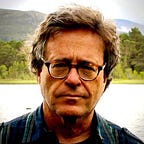The Art of Distance Hugging
Disengaging Fear
A social distancing hug need not be a paltry pantomime. If eyes are the window to the soul, then traditional hugs are shades drawn. But extending the moment before the hug — the mutual gaze of delight in each other’s presence — keeps the light shining through.
Also, the impulse to give a hug — to reach out toward someone with love— is the opposite of the impulse to avoid — to contract away from someone in fear. This love/fear opposition can be felt well before the contrasting final gestures of arms encircling another versus arms pulled into oneself. A loving hug is first felt in your hands, extending the arms from the fingers. A fearful contraction is first felt in the shoulders, pulling the arms in. Moving arms not from the shoulders but from the fingers is a foundation of Taiji
and energetic coherence, because tensing the shoulders blocks the flow of qi (chi). But the arms do not need to move at all to experience the contrast. Next time you wish to (but cannot)hug a beloved friend 6 feet away, initiate a non-contact hug, and feel your fingers come alive.
The longer you sustain your non-contact hug, the more qi you will feel in both hands, as a tingling. That tingling, the increased blood flow, is the activation of qi. And it can be felt not only in the hands, but between the hands, like the energetic field of opposing magnets. Eventually, this same energetic field can be shared with another standing 6 feet away.
Such sharing is like “making” love. You no more make qi than you make love. In both, you only get out of the way — whether it be the muscle tension disconnecting you from qi flow, or the reverberating sense of self isolating you from relationship. Qi and love manifest like well water. You don’t create the water, you just remove the dirt that’s blocking its emergence. A distance hug, with the most minimal of doing, simultaneously manifests both qi and love.
